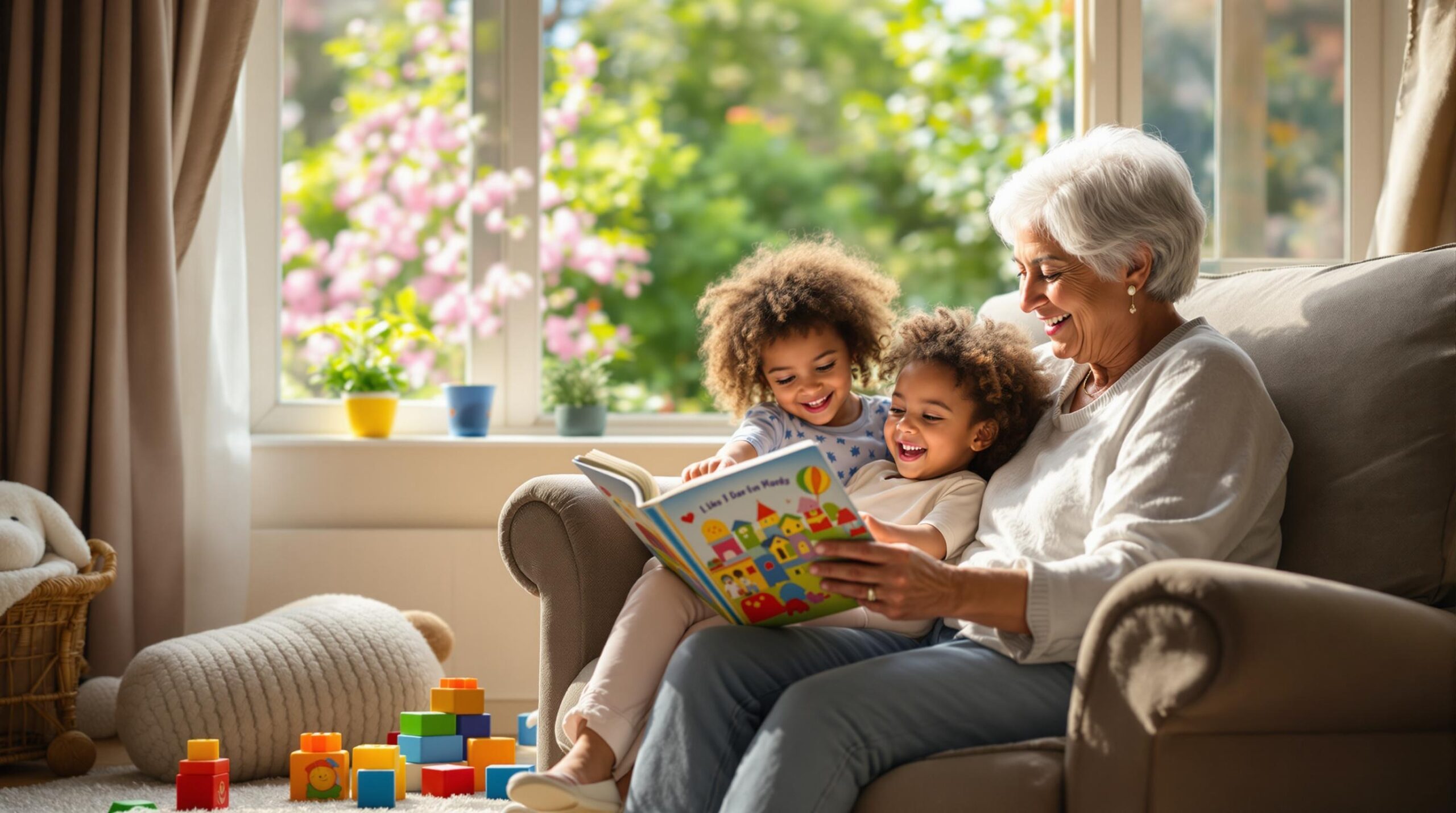Table of Contents
ToggleGrandparenting is a joyful experience that brings a unique set of challenges and rewards. As a grandparent, you play a crucial role in your grandchild’s life, offering love, support, and wisdom. However, it’s essential to establish clear boundaries to ensure a harmonious relationship with both your grandchildren and their parents. This comprehensive guide will explore the dos and don’ts of grandparenting, focusing on setting appropriate boundaries while nurturing a strong bond with your grandchildren.
Understanding Child Development Stages: A Guide for Grandparents
To effectively set boundaries and interact with your grandchildren, it’s crucial to understand the different stages of child development. Jean Piaget’s cognitive development theory provides a helpful framework for understanding how children think and learn at various ages.
Sensorimotor Stage (0-2 years)
During this stage, infants and toddlers learn about the world through their senses and motor actions. They develop object permanence, understanding that objects continue to exist even when out of sight. As a grandparent, you can support this stage by:
- Playing peek-a-boo to reinforce object permanence
- Providing safe objects for exploration and mouthing
- Engaging in sensory activities like finger painting or water play
Preoperational Stage (2-7 years)
Children in this stage develop symbolic thought, using words and images to represent objects. They’re egocentric, struggling to see things from others’ perspectives. To support your grandchild during this stage:
- Encourage imaginative play with dress-up clothes or toy kitchens
- Read picture books together, discussing the stories and characters
- Play simple board games to help develop turn-taking skills
Concrete Operational Stage (7-11 years)
Children begin to think logically about concrete events, understanding concepts like conservation of number, mass, and volume. They can classify objects and understand reversibility. Support this stage by:
- Introducing science experiments that demonstrate cause and effect
- Playing strategy games that require logical thinking
- Encouraging collections and helping them organize and categorize items
Formal Operational Stage (12+ years)
Adolescents develop the ability to think abstractly and reason hypothetically. They can engage in more complex problem-solving and consider multiple perspectives. To support this stage:
- Discuss current events and encourage them to form their own opinions
- Introduce more complex puzzles or brain teasers
- Engage in debates or discussions about abstract concepts
Understanding these stages will help you tailor your interactions and set appropriate boundaries for your grandchild’s developmental level.

Setting Age-Appropriate Boundaries: Tailoring Rules to Your Grandchild’s Development
Setting boundaries is crucial for maintaining a healthy relationship with your grandchildren and their parents. These boundaries should be adjusted based on the child’s age and developmental stage.
Toddlers (1-3 years)
For toddlers, boundaries should be simple and consistently enforced. Focus on safety and basic behavioral expectations:
- Use clear, short phrases like “Gentle hands” or “Walking feet”
- Establish a consistent routine for meals, naps, and bedtime
- Childproof your home to create a safe environment for exploration
- Address separation anxiety by creating a goodbye ritual and reassuring the child you’ll return
Preschoolers (3-5 years)
As children enter preschool age, they can understand more complex rules and social behaviors:
- Introduce the concept of sharing and taking turns
- Set clear expectations for behavior in different settings (e.g., indoor voices, outdoor voices)
- Use positive reinforcement to encourage good behavior
- Explain the reasons behind rules in simple terms
School-age children (6-12 years)
Older children can understand and follow more detailed rules:
- Involve them in setting some of the rules for their visits
- Explain the consequences of breaking rules and follow through consistently
- Discuss internet and screen time rules
- Set expectations for respectful communication and behavior
Remember, physical boundaries are crucial for younger children’s safety, while emotional support becomes increasingly important as they grow older. Always consult with parents to ensure your boundaries align with their parenting approach.
Promoting Positive Interactions: Fostering Values and Creativity
As a grandparent, you have a unique opportunity to promote positive values and foster creativity in your grandchildren. This not only enhances their development but also strengthens your bond.
Encouraging Positive Values
Focus on instilling important values such as kindness, respect, and honesty:
- Model these behaviors in your own actions and interactions
- Praise your grandchild when they demonstrate these values
- Use stories or role-playing to illustrate positive behaviors
- Discuss the impact of their actions on others to develop empathy
Fostering Creativity
Engaging in creative activities can boost cognitive development and self-expression:
- Set up an art corner with various materials for free expression
- Encourage storytelling by creating stories together or using story prompts
- Engage in imaginative play, letting your grandchild take the lead
- Introduce music and movement activities to foster creativity and physical development
These positive interactions help grandparents stay involved in their grandchildren’s lives while supporting their overall development.
Maintaining Open Communication with Parents: Ensuring Alignment and Transparency
Open communication with your grandchild’s parents is vital for maintaining healthy relationships and ensuring consistent care. Regular discussions about boundaries, activities, and any issues that arise can prevent misunderstandings and conflicts.
Strategies for Aligning with Parents’ Expectations
- Schedule regular check-ins to discuss rules and expectations
- Ask for clarification on any unclear guidelines
- Be open to feedback and willing to adjust your approach
- Share your own experiences and insights respectfully, without undermining parental authority
Topics to Discuss with Parents
- Discipline methods and how to handle misbehavior
- Screen time rules and appropriate content
- Dietary restrictions or preferences
- Sleep schedules and bedtime routines
- Safety concerns and emergency procedures
By maintaining open communication, you can support parents without overstepping boundaries, creating a harmonious family dynamic.
Ensuring Online Safety: Navigating the Digital World with Your Grandchild
In today’s digital age, online safety is a crucial concern for grandparents. It’s important to understand the risks and take steps to protect your grandchildren while they explore the digital world.
Monitoring Content and Using Parental Controls
- Familiarize yourself with parental control settings on devices and platforms
- Use child-friendly browsers and search engines
- Set up content filters to block inappropriate websites
- Monitor screen time and set limits as agreed upon with parents
Educating Children About Online Risks
- Discuss the importance of privacy and not sharing personal information online
- Teach them about cyberbullying and how to respond if they encounter it
- Explain the permanence of online posts and the importance of thinking before sharing
- Encourage open communication about their online experiences
By taking these steps, you can help ensure your grandchild’s safety in the digital world while still allowing them to benefit from technology.
Encouraging Diverse Representation: Broadening Your Grandchild’s Horizons
Exposing your grandchild to diverse cultures, ethnicities, and lifestyles can foster understanding, empathy, and inclusivity. This exposure is crucial in today’s interconnected world.
Incorporating Diversity in Activities and Media
- Choose books, movies, and TV shows featuring diverse characters and stories
- Attend cultural festivals or events in your community
- Cook meals from different cultures together
- Discuss different family structures and lifestyles in an age-appropriate manner
Benefits of Diverse Representation
- Develops cultural awareness and sensitivity
- Promotes empathy and understanding of others’ perspectives
- Prepares children for a diverse, global society
- Encourages critical thinking about stereotypes and biases
By promoting diverse representation, you can help your grandchild develop into a more open-minded and empathetic individual.
Monitoring Developmental Milestones: Supporting Your Grandchild’s Growth
Understanding and monitoring developmental milestones can help you support your grandchild’s growth and identify any potential concerns early on.
Key Developmental Milestones
- 9 months: Develops object permanence
- 12-14 months: Begins walking independently
- 18 months: Uses 10-20 words
- 2 years: Combines words into short phrases
- 3 years: Engages in imaginative play
- 4 years: Can draw a person with 2-4 body parts
- 5 years: Can count 10 or more objects
Supporting Developmental Progress
- Engage in age-appropriate activities that challenge your grandchild’s skills
- Provide plenty of opportunities for physical activity and exploration
- Read together regularly to support language development
- Encourage independence in daily tasks like dressing or eating
Remember, every child develops at their own pace. If you have concerns about your grandchild’s development, discuss them with their parents and healthcare provider.
Engaging in Interactive Activities: Fostering Cognitive and Social Development
Interactive activities play a crucial role in children’s cognitive and social development. These activities can be tailored to different developmental stages and provide numerous benefits.
Benefits of Interactive Activities
- Enhances problem-solving skills
- Improves communication and language abilities
- Develops fine and gross motor skills
- Boosts creativity and imagination
- Strengthens social skills and emotional intelligence
Age-Appropriate Interactive Activities
- Infants: Peek-a-boo, singing songs with hand motions, simple tactile toys
- Toddlers: Building blocks, simple puzzles, finger painting
- Preschoolers: Memory games, pretend play, simple board games
- School-age children: Strategy games, science experiments, collaborative art projects
These activities not only support your grandchild’s development but also create wonderful opportunities for bonding and creating lasting memories.
Prioritizing Physical and Emotional Safety: Creating a Secure Environment
Ensuring both physical and emotional safety is paramount when caring for your grandchildren. A secure environment allows children to explore, learn, and grow with confidence.
Creating a Safe Physical Environment
- Childproof your home by covering electrical outlets, securing furniture, and removing hazardous items
- Keep emergency contact information readily available
- Learn basic first aid and CPR
- Supervise activities closely, especially around water or during outdoor play
Providing Emotional Support and Reassurance
- Create a consistent and predictable routine
- Offer comfort and reassurance during times of stress or anxiety
- Listen actively to your grandchild’s concerns and validate their feelings
- Maintain a calm and patient demeanor, even in challenging situations
By prioritizing both physical and emotional safety, you create an environment where your grandchild can thrive and feel secure in your care.
Grandparenting is a wonderful journey filled with love, learning, and growth. By understanding child development, setting appropriate boundaries, and fostering positive interactions, you can create a nurturing relationship with your grandchildren. Remember to maintain open communication with parents, prioritize safety, and embrace the unique joys that come with being a grandparent. Whether you’re a first-time grandparent or have years of experience, these guidelines will help you navigate the rewarding path of grandparenthood. For those grandparenting from afar, many of these principles can be adapted to maintain a strong connection across distances. By following these dos and don’ts, you’ll be well-equipped to create lasting, positive memories with your grandchildren while respecting the boundaries set by their parents.
Sources:
Piaget Cognitive Stages of Development – WebMD
Evidence-based milestone ages as a framework for developmental surveillance – PMC
The NICHD Study of Early Child Care and Youth Development – NIH












